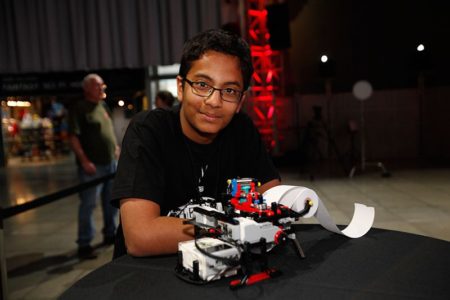
12-year-old Shubham Banerjee’s interest in Braille and Braille printers evolved out of his love for science. While doing research for an engineering project to enter for a science fair in January of 2014, he discovered that less than 10% of blind people can actually read Braille. This was, in part, due to the extremely high prices of Braille printers, costing around $2,000. Additionally, technological advancements such as the development of voice-to-text software significantly impacted the lives of the visually impaired. Banerjee realized that many visually impaired people were not able to afford the extremely expensive Braille printers, or the technology needed to efficiently communicate without one. Therefore, his new goal was to significantly reduce the cost of a Braille printer.
Banerjee worked for weeks to create a working prototype. After seven attempts, he finally successfully created a prototype using a Lego Mindstorms EV3 robotics kit and some small electrical components. Banerjee and his father, a software engineer, would often stay up until 2 a. m. working on the project together. At 13 years old, a high school freshman, Banerjee founded Braigo, the company name combining the words Braille and Lego. Braigo was a low-cost, portable printer and embosser that prints out raised bumps on paper. Banerjee also co-founded the company Braigo Labs to further develop the printer. Banerjee was faced with a lot of criticism and uncertainty because many Silicon Valley startups had tried to undertake the same project without success. He did not let this affect his work and research, however, and persevered through the difficult times. “Some [people] said that the market is not that big, or [that this is] a specialty product,” Banerjee says, unfazed. “I just went ahead with what I thought was right.”
The Braigo printed proved a success even while in its early stages. Banerjee entered his product into the 2014 Synopsis Science Fair and took home the top prize for a science or engineering breakthrough. It was also endorsed by Henry Wedler, a PhD candidate in organic chemistry who was honored by Barack Obama as a Champion of Change for his work leading a chemistry camp for visually impaired students. As Wedler puts it, “Inventors have been attempting to do what Shubham has done with Braille embossers for many years. Sometimes, it takes a young, fresh imagination and a will of iron to be truly innovative. This is the energy and quality that Shubham’s knowledge and passion as an inventor bring to Silicon Valley.” Banerjee and his company, Braigo Labs, managed to bring in venture capital to ensure the success of his company, becoming the youngest person ever to receive venture capitalist investment, according to CBS. Banerjee’s innovative spirit helped to better the lives of the visually impaired, while also encouraging and promoting others to follow in his footsteps.
To learn more about Shubham Banerjee and Braigo , click here.


